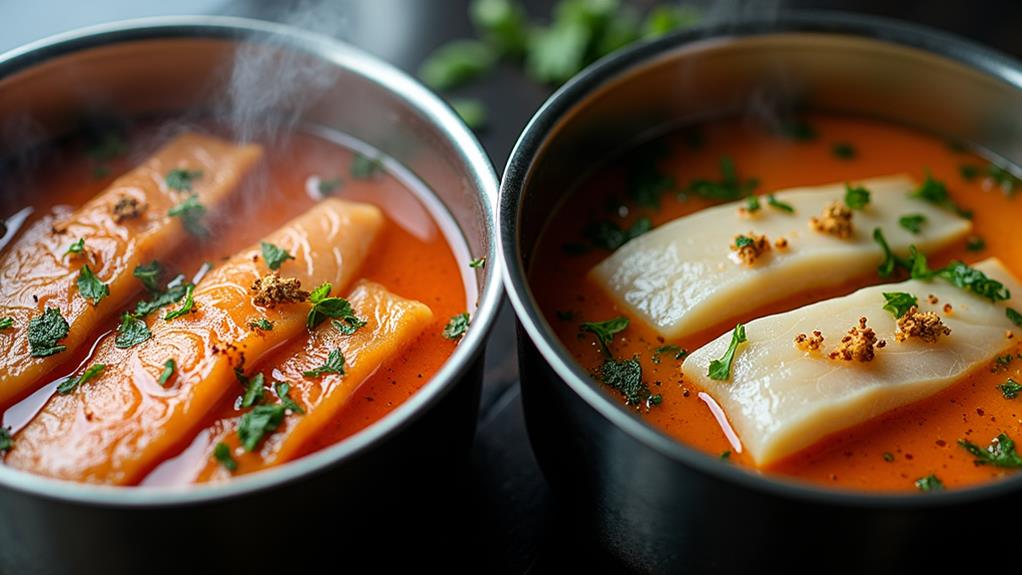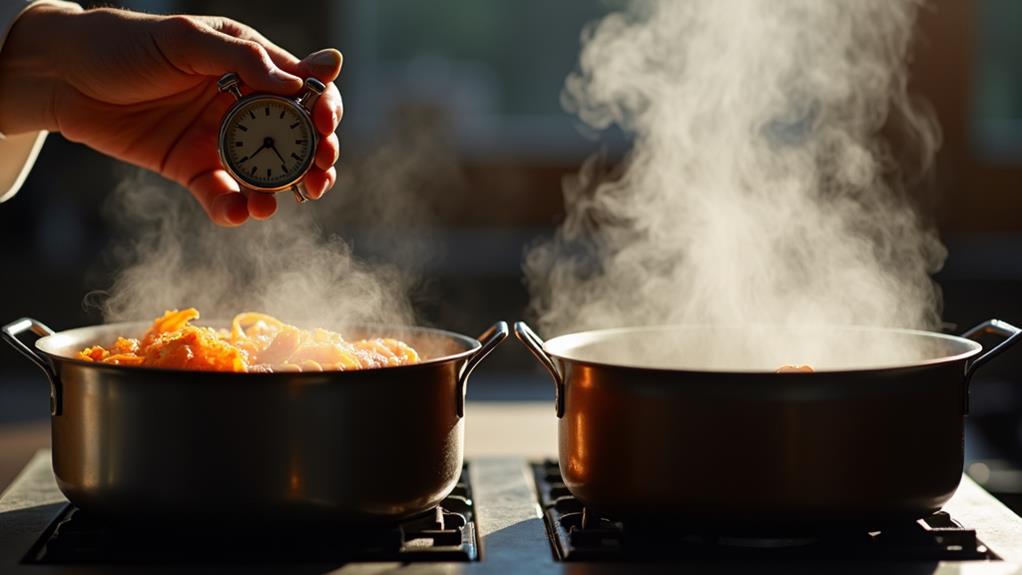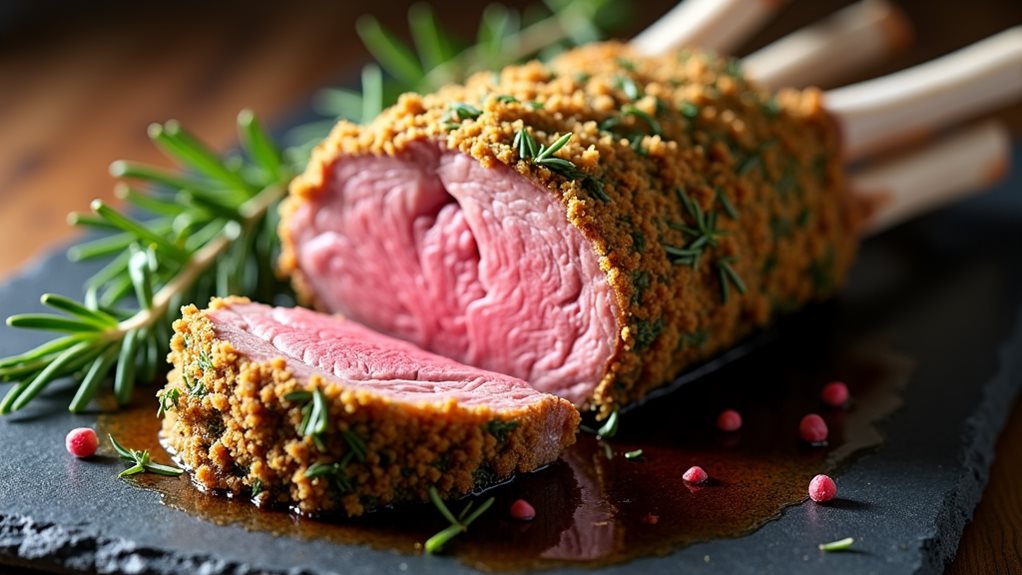Mastering boiling and poaching can elevate your culinary skills dramatically. While boiling occurs at 212°F, creating firm textures ideal for pasta and vegetables, poaching operates between 160-180°F, preserving delicate proteins' integrity. Both methods use water as a base, but experimenting with flavored liquids like broths or wine can enhance taste profiles. Timing is crucial: boiling requires shorter durations, while poaching demands patience for even results. Infuse herbs and aromatics to amplify flavors, adjusting intensity based on the cooking method. Boiling suits robust foods, while poaching excels with delicate ingredients like fish or eggs. By understanding these techniques, you'll unlock a world of versatile culinary applications and flavor possibilities.
Temperature: The Key Differentiator
The primary distinction between boiling and poaching lies in the temperature of the cooking liquid. When you're boiling, you're exposing food to water at its boiling point, typically 212°F (100°C) at sea level. This high temperature creates rapid, vigorous bubbling that can be quite aggressive on delicate foods.
In contrast, poaching methods employ gentler heat, usually between 160°F and 180°F (71-82°C). This lower temperature range allows for a more controlled cooking process, ideal for preserving the integrity of tender ingredients.
Understanding these temperature differences is crucial for mastering various cooking techniques. Boiling's intense heat is perfect for tougher foods that need thorough cooking, like pasta or root vegetables. It's also essential for sterilization and rapid flavor extraction.
Poaching, however, offers a more nuanced approach. You'll find it's excellent for infusing subtle flavors and maintaining the moistness of proteins like fish or chicken. By carefully controlling the temperature, you're able to achieve precise doneness without overcooking.
This method also allows for the creation of flavorful cooking liquids that can be repurposed as sauces or bases for other dishes, adding an innovative twist to your culinary repertoire.
Liquid Mediums Explored
When you're exploring liquid mediums for boiling and poaching, you'll find that water is the most common base, but you can also use flavored liquids like broths or wine to infuse more taste into your food.
The choice of liquid will affect both the cooking time and the final flavor profile of your dish, so it's important to consider your recipe's requirements.
Remember that the temperature and timing for each method will vary depending on the liquid you choose, with denser or more viscous liquids often requiring adjustments to achieve the desired results.
Water-Based vs. Flavored Liquids
Regarding liquid mediums, both boiling and poaching offer versatile options. When choosing between water-based and flavored liquids, you'll want to consider your culinary goals. For instance, you might find that using ingredients like butternut squash can add nutritional value and a touch of sweetness to your dishes, similar to the way it enhances Butternut Squash Mac and Cheese.
Water-based liquids, like plain water or stock, provide a neutral foundation that allows the natural flavors of your ingredients to shine. The water clarity in these mediums ensures that you can easily monitor the cooking process and achieve precise results.
On the other hand, flavored liquids introduce an exciting dimension to your dishes. By using wine, broth, or infused oils, you're not just cooking but also infusing your food with complex tastes. The liquid viscosity of these mediums can vary, affecting how flavors are absorbed and distributed throughout your dish.
For delicate items like fish or eggs, a lighter flavored liquid might be ideal, while heartier ingredients can stand up to more robust flavors.
Experiment with both water-based and flavored liquids to expand your culinary repertoire. You'll discover that each medium offers unique advantages, allowing you to tailor your cooking technique to achieve the perfect balance of flavor and texture in your creations.
Temperature and Timing Considerations
Mastering temperature control and timing is key to successful boiling and poaching. When boiling, you'll want to bring your liquid to a rolling boil, typically around 212°F (100°C) at sea level. This high temperature is ideal for cooking pasta, vegetables, and tougher cuts of meat.
However, poaching requires a gentler approach, with temperature ranges between 160°F to 180°F (71°C to 82°C). This lower heat allows for more delicate items, like eggs or fish, to cook slowly and evenly without becoming tough or dry.
Timing precision is crucial in both methods. For boiling, you'll often work with shorter cooking times, as the intense heat cooks food quickly. Pasta might take 8-12 minutes, while vegetables could be done in 3-5 minutes.
Poaching, on the other hand, requires longer cooking times due to the lower heat. A chicken breast might take 15-20 minutes to poach, while eggs could need 3-4 minutes for the perfect runny yolk.
Always use a timer and check for doneness to achieve optimal results in your culinary experiments.
Flavor Infusion Techniques

When infusing flavor into your poached or boiled dishes, you'll find herbs and aromatics to be invaluable allies. Adding ingredients like bay leaves, thyme sprigs, or garlic cloves to your cooking liquid can impart subtle yet delicious notes to your food.
Herbs and Aromatics
Flavor infusion is a key difference between boiling and poaching. When you're looking to elevate your culinary creations, understanding how to use herbs and aromatics effectively can transform your dishes.
In poaching, you'll find that delicate herb combinations can impart subtle flavors without overpowering the main ingredient. For instance, consider pairing thyme with lemon zest for poached fish, or adding a bay leaf and peppercorns to poached chicken for a classic aromatic profile. You can also use seasonal vegetables to enhance your poached dishes, just as featured in Harvest Vegetable Soup.
Boiling, on the other hand, allows for bolder flavor infusions. You can create robust broths by combining herbs like rosemary, sage, and oregano with aromatic vegetables such as onions and garlic. These intense flavors will permeate your ingredients more thoroughly during the boiling process.
To innovate, try unexpected herb combinations like cilantro and mint in a boiled soup base, or experiment with aromatic profiles by incorporating star anise or lemongrass into your boiling liquid. Remember, the key to mastering flavor infusion lies in balancing the intensity of your herbs and aromatics with the cooking method you choose.
Liquid Selection Matters
The choice of liquid can make or break your dish when it comes to boiling and poaching. Your selection impacts both flavor intensity and liquid viscosity, influencing the final outcome of your culinary creation. When aiming for innovation in the kitchen, consider these four unconventional options:
- Coconut water for a subtle tropical essence
- Green tea for a delicate, earthy undertone
- Bone broth for rich, savory depth
- Fruit juices for a sweet-tart twist
Each liquid brings its unique properties to the cooking process. Water, while neutral, allows other flavors to shine. Stocks and broths impart richness, while wine adds complexity and acidity.
Milk and cream create velvety textures, perfect for poaching delicate items. For a nutritious and versatile option, lentils can also be prepared with flavorful liquids to enhance their natural goodness, such as a nutritious base like vegetable broth.
Consider the liquid's viscosity when choosing your medium. Thicker liquids, like cream-based solutions, cling to foods more readily, intensifying flavor absorption. Conversely, thinner liquids allow for gentler cooking and more subtle flavor infusion.
Experiment with layering liquids to create multi-dimensional flavor profiles. Start with a base liquid and add complementary flavors as you cook. This technique allows you to build depth and complexity in your dishes, elevating your culinary skills to new heights.
Textural Variations Unveiled
Delving into the textural differences between boiled and poached foods reveals a world of culinary nuance.
These cooking techniques yield distinct texture profiles, each offering unique sensory experiences. When you boil food, you'll notice a firmer, sometimes tougher texture due to the aggressive heat and turbulent water. This method is ideal for foods that benefit from a more robust bite, like pasta or certain vegetables.
Poaching, on the other hand, creates a gentler environment for your ingredients. The result? Tender, delicate textures that melt in your mouth. You'll find this technique particularly useful for proteins like fish or eggs, where maintaining moisture and preventing toughness is crucial.
By controlling the temperature and using a flavorful liquid, you can infuse your food with subtle tastes while preserving its inherent texture.
To master these techniques, experiment with different ingredients and observe how they respond. Try poaching chicken breast for a juicy, tender result, then compare it to a boiled counterpart.
You'll quickly discern the textural variations and learn when to apply each method for optimal results in your culinary creations.
Mastering the Timing Aspect

Perfecting the timing aspect of boiling and poaching can make or break your dish. Mastering these timing techniques isn't just about following a recipe; it's about understanding the science behind optimal durations for different ingredients.
When you're boiling or poaching, consider these key factors:
- The size and density of your ingredient
- The starting temperature of your water
- The desired level of doneness
- The altitude at which you're cooking
For boiling, you'll generally want to start with a rolling boil, then reduce to a simmer. This method works well for pasta, vegetables, and eggs.
Poaching, on the other hand, requires gentler heat and longer cooking times. It's ideal for delicate items like fish, chicken, and eggs.
To innovate your cooking, try experimenting with different timing techniques. For example, you might blanch vegetables briefly in boiling water, then shock them in ice water to maintain crispness.
Or, you could try the French method of "shock poaching," where you start with cold liquid and gradually increase the heat.
Versatile Applications Showcased
Explore the wide-ranging applications of boiling and poaching to expand your culinary repertoire. These versatile techniques can be applied to a variety of ingredients, from delicate fish and tender vegetables to hearty meats and robust grains.
When boiling, you'll find it's ideal for pasta, potatoes, and eggs, creating a foundation for countless dish combinations. Experiment with infusing your boiling liquid with herbs, spices, or aromatics to add depth to your final product.
Poaching, on the other hand, excels in preserving the integrity of delicate proteins like chicken breast, fish fillets, and eggs. This gentle cooking method allows you to infuse subtle flavors into your ingredients, opening up possibilities for innovative sauce pairings.
Try poaching fruit in wine or spiced syrup for a sophisticated dessert, or use the technique to create tender, flavorful additions to salads and sandwiches.
Frequently Asked Questions
Can You Boil or Poach Frozen Foods Directly?
You can directly boil or poach frozen foods, but it's not always ideal. For optimal results, try innovative cooking techniques like sous vide or flash-thawing. These methods help preserve texture and flavor while ensuring food safety.
Are There Health Benefits to Choosing Poaching Over Boiling?
You'll be blown away by poaching's benefits! It's a game-changer for nutrient retention and flavor enhancement. You'll preserve more vitamins and minerals while infusing delicate flavors. Embrace this innovative technique to revolutionize your healthy cooking game.
How Do Altitude Changes Affect Boiling and Poaching Times?
You'll need to adapt your cooking times as altitude rises. Water boils at lower temperatures, extending both boiling and poaching durations. Embrace this challenge by experimenting with innovative cooking adjustments to perfect your high-altitude culinary creations.
What Are the Best Pots or Pans for Boiling and Poaching?
Dive into a sea of culinary possibilities with smart saucepan selection. You'll want stainless steel or copper pots for even heat distribution. For poaching, choose a wide, shallow pan. Experiment with materials to revolutionize your boiling and poaching game.
Can You Reuse Poaching Liquid for Multiple Batches of Food?
You can definitely reuse poaching liquid for multiple batches. It's a game-changer for flavor retention and sustainability. Just strain it, refrigerate, and reheat. You'll unlock new depths of taste with each use. Experiment and innovate!
Final Thoughts
As you've navigated the culinary waters of boiling and poaching, you've learned to harness temperature, liquid mediums, and timing to create masterful dishes. Like a skilled conductor leading an orchestra, you now possess the ability to coax subtle flavors and perfect textures from your ingredients. Whether you're gently poaching an egg or vigorously boiling pasta, you're no longer just cooking – you're orchestrating a symphony of flavors. Armed with these techniques, you'll transform every meal into a culinary masterpiece.















